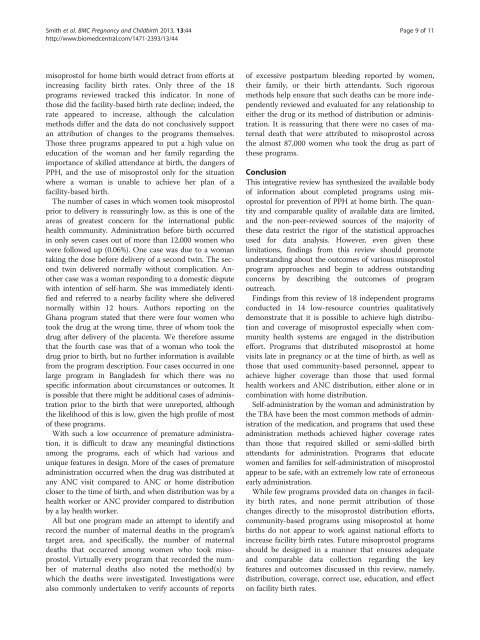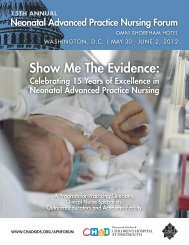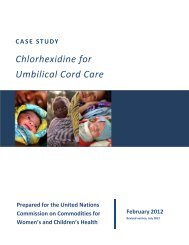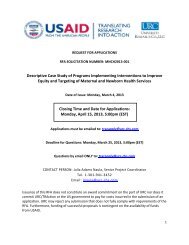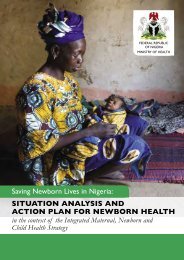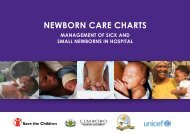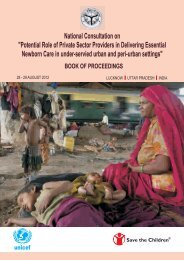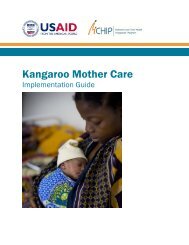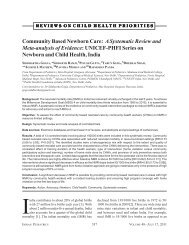Misoprostol for postpartum hemorrhage prevention ... - BioMed Central
Misoprostol for postpartum hemorrhage prevention ... - BioMed Central
Misoprostol for postpartum hemorrhage prevention ... - BioMed Central
You also want an ePaper? Increase the reach of your titles
YUMPU automatically turns print PDFs into web optimized ePapers that Google loves.
Smith et al. BMC Pregnancy and Childbirth 2013, 13:44 Page 9 of 11http://www.biomedcentral.com/1471-2393/13/44misoprostol <strong>for</strong> home birth would detract from ef<strong>for</strong>ts atincreasing facility birth rates. Only three of the 18programs reviewed tracked this indicator. In none ofthose did the facility-based birth rate decline; indeed, therate appeared to increase, although the calculationmethods differ and the data do not conclusively supportan attribution of changes to the programs themselves.Those three programs appeared to put a high value oneducation of the woman and her family regarding theimportance of skilled attendance at birth, the dangers ofPPH, and the use of misoprostol only <strong>for</strong> the situationwhere a woman is unable to achieve her plan of afacility-based birth.The number of cases in which women took misoprostolprior to delivery is reassuringly low, as this is one of theareas of greatest concern <strong>for</strong> the international publichealth community. Administration be<strong>for</strong>e birth occurredin only seven cases out of more than 12,000 women whowere followed up (0.06%). One case was due to a womantaking the dose be<strong>for</strong>e delivery of a second twin. The secondtwin delivered normally without complication. Anothercase was a woman responding to a domestic disputewith intention of self-harm. She was immediately identifiedand referred to a nearby facility where she deliverednormally within 12 hours. Authors reporting on theGhana program stated that there were four women whotook the drug at the wrong time, three of whom took thedrug after delivery of the placenta. We there<strong>for</strong>e assumethat the fourth case was that of a woman who took thedrug prior to birth, but no further in<strong>for</strong>mation is availablefrom the program description. Four cases occurred in onelarge program in Bangladesh <strong>for</strong> which there was nospecific in<strong>for</strong>mation about circumstances or outcomes. Itis possible that there might be additional cases of administrationprior to the birth that were unreported, althoughthe likelihood of this is low, given the high profile of mostof these programs.With such a low occurrence of premature administration,it is difficult to draw any meaningful distinctionsamong the programs, each of which had various andunique features in design. More of the cases of prematureadministration occurred when the drug was distributed atany ANC visit compared to ANC or home distributioncloser to the time of birth, and when distribution was by ahealth worker or ANC provider compared to distributionby a lay health worker.All but one program made an attempt to identify andrecord the number of maternal deaths in the program’starget area, and specifically, the number of maternaldeaths that occurred among women who took misoprostol.Virtually every program that recorded the numberof maternal deaths also noted the method(s) bywhich the deaths were investigated. Investigations werealso commonly undertaken to verify accounts of reportsof excessive <strong>postpartum</strong> bleeding reported by women,their family, or their birth attendants. Such rigorousmethods help ensure that such deaths can be more independentlyreviewed and evaluated <strong>for</strong> any relationship toeither the drug or its method of distribution or administration.It is reassuring that there were no cases of maternaldeath that were attributed to misoprostol acrossthe almost 87,000 women who took the drug as part ofthese programs.ConclusionThis integrative review has synthesized the available bodyof in<strong>for</strong>mation about completed programs using misoprostol<strong>for</strong> <strong>prevention</strong> of PPH at home birth. The quantityand comparable quality of available data are limited,and the non-peer-reviewed sources of the majority ofthese data restrict the rigor of the statistical approachesused <strong>for</strong> data analysis. However, even given theselimitations, findings from this review should promoteunderstanding about the outcomes of various misoprostolprogram approaches and begin to address outstandingconcerns by describing the outcomes of programoutreach.Findings from this review of 18 independent programsconducted in 14 low-resource countries qualitativelydemonstrate that it is possible to achieve high distributionand coverage of misoprostol especially when communityhealth systems are engaged in the distributionef<strong>for</strong>t. Programs that distributed misoprostol at homevisits late in pregnancy or at the time of birth, as well asthose that used community-based personnel, appear toachieve higher coverage than those that used <strong>for</strong>malhealth workers and ANC distribution, either alone or incombination with home distribution.Self-administration by the woman and administration bythe TBA have been the most common methods of administrationof the medication, and programs that used theseadministration methods achieved higher coverage ratesthan those that required skilled or semi-skilled birthattendants <strong>for</strong> administration. Programs that educatewomen and families <strong>for</strong> self-administration of misoprostolappear to be safe, with an extremely low rate of erroneousearly administration.While few programs provided data on changes in facilitybirth rates, and none permit attribution of thosechanges directly to the misoprostol distribution ef<strong>for</strong>ts,community-based programs using misoprostol at homebirths do not appear to work against national ef<strong>for</strong>ts toincrease facility birth rates. Future misoprostol programsshould be designed in a manner that ensures adequateand comparable data collection regarding the keyfeatures and outcomes discussed in this review, namely,distribution, coverage, correct use, education, and effecton facility birth rates.


